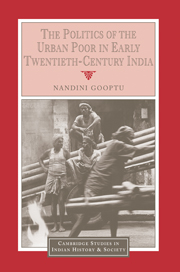1 - The study and its perspectives
Published online by Cambridge University Press: 05 July 2014
Summary
I
The simultaneous and unprecedented expansion of the politics of class, community and nationalism marked a decisive transition in the history of the Indian subcontinent in the years between the two world wars. At the heart of this political transformation lay the emergence of ‘mass’ movements and widespread popular political action, the nature and terms of which form the central theme of this book. It illuminates how the popular classes inscribed their own space in, and thus also determined the direction of, caste, communal and nationalist movements. The focus is on the poor in towns, who have received little attention from historians compared with their rural counterparts. Yet, in the interwar years, various parts of the subcontinent underwent extensive urbanisation and urban demographic expansion, and towns became central to political developments in the country, with the poor coming to play a pivotal role. Arguably, the urban poor contributed substantially to the transformation of Indian politics in this period, and our understanding of the nature of mass politics and political conflict in late-colonial India might be significantly modified by approaching the subject from this perspective.
The politics of the urban working classes have not, of course, been entirely ignored in Indian historiography. Most works, however, give only a partial picture. Studies usually concentrate on factory workers, and they deal largely with politics arising from the experience of work or workplace relations. However, urban workforces are not clearly differentiated between formal or organised sector factory-hands and the rest: casual, unorganised labour in the informal sector.
- Type
- Chapter
- Information
- Publisher: Cambridge University PressPrint publication year: 2001

